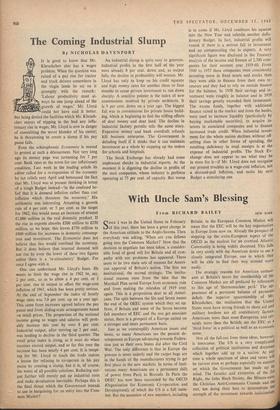The Coming Industrial Slump
By NICHOLAS DAVENPORT
Even the schizophrenic Economist is moved to protest at such a denouement. Not very long ago its money page was screaming for 7 per cent. Bank rates as the norm for our inflationary condition. Last week in the leading article its editor called for a re-expansion of the economy by tax reliefs next April and bemoaned the fact that Mr. Lloyd was at present thinking in terms of a tough Budget instead-1n the confused be- lief that it is demand inflation rather than cost inflation which threatens the economy.' His arithmetic was interesting. Assuming a growth rate of 4 per cent. or 5 per cent. as the target for 1962, this would mean an increase of around £1,000 million in the real domestic product. If the rise in exports absorbs £200 million to £250 million, as we hope, this leaves £750 million to £800 million for, increases in domestic consump- tion and investment. The Economist does not believe that this would overload the economy. But it does believe that internal demand will not rise by even the lower of these two figures unless there is a 're-stimulatory' Budget. For once I agree with it.
One can understand Mr. Lloyd's fears. He wants to limit the wage rise in 1962 to, say, 2 per cent., so as to allow a 4 per cent. or 5 per cent. rise in output to offset the wage-cost inflation of 1961, which has been pretty serious. At the end of September the index of hourly wage rates was 5.8 per cent. up on a year ago. This came from increases agreed before the pay pause and from sliding-scale arrangements based on retail prices. The proportion of the national income going to wages and salaries will prob- ably increase this year by over 8 per cent. Industrial output, after moving up 2 per cent., was tending to decline in the third quarter. The retail price index is rising, as it must do when incomes exceed output, and so far this year the increase has been nearly 4 per cent. It is tempt- ing for Mr. Lloyd to teach the trade unions a lesson for refusing to co-operate in his pay pause by creating a slump, but it is, of course, the worst of all possible solutions. Reducing out- put further will merely put up industrial costs and make devaluation inevitable. Perhaps this is the final threat which the Government intends to use in bargaining for an entry into the Com- mon Market? An industrial slump is quite easy to generate. Industrial profits in the first half of the year were already 8 per cent. down and, as output falls, the decline in profitability will worsen. Mr. Lloyd has only to keep on his credit squeeze and high money rates for another three or four months to cause private investment to run down sharply. A sensitive pointer is the index of new commissions received by private architects. It is 9 per cent. down on a year ago. The biggest fall was in commissions for private houie build- ing, which is beginning to feel the stifling effects of dear money and dear land. The decline in industrial factory permits tells the same story. Expensive money and bank overdraft refusals kill business enterprise. The Government is deluding itself if it thinks that it can maintain investment as a whole by stepping up the orders for schools and hospitals.
The Stock Exchange has already had some unpleasant shocks in industrial reports. At the moment it is digesting the decline in profits of the steel companies, whose industry is perforce operating at 75 per cent. of capacity. But worse is to come if Mr. Lloyd continues his squeeze into the New Year and submits another defla- tionary Budget. In fact, industrial profits will vanish if there is a serious fall in investment and no compensating rise in exports. A very significant figure was disclosed in the Treasury analysis of the income and finance of 2,700 com- panies for their account year 1959-60. From 1949 to 1957 these companies were consistently investing more in fixed assets and stocks than they were able to finance from their own re- sources and they had to rely on outside finance for the balance. In 1958 their savings and in- vestment were roughly in balance and in 1959 their savings greatly exceeded their investment. The excess funds, together with additional finance raised in the market and from the banks, were used to increase liquidity (particularly by buying marketable securities), to acquire in- terests in associated companies and to finance increased trade credit. When industrial invest- ment for the whole nation declines without off- setting rises in other forms of spending, the resulting deficiency in total receipts is at the expense of industrial profits. The Stock Ex- change does not appear to see what may be in store for it—if Mr. Lloyd does not recognise our present troubles as a wage-cost inflation, not a demand-pull inflation, and make his next Budget a stimulating one.


































 Previous page
Previous page